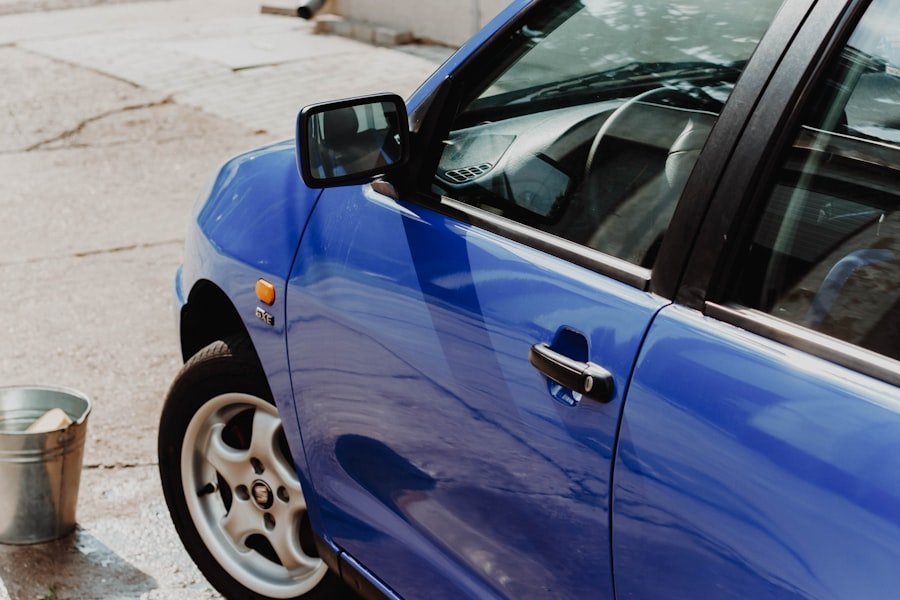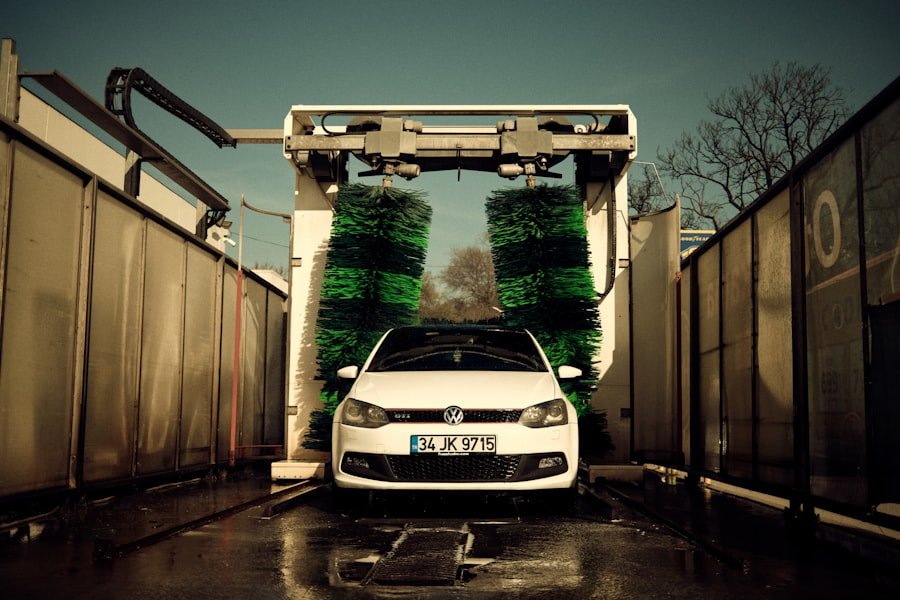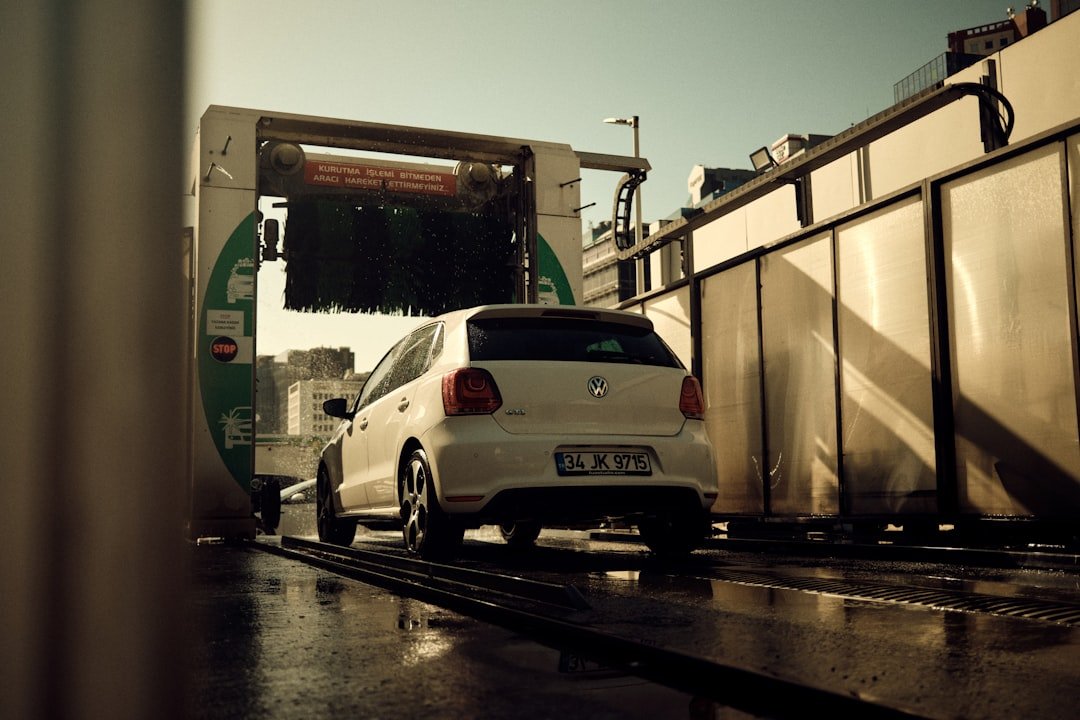Regular car washing is an essential aspect of vehicle maintenance that goes beyond mere aesthetics. A clean car not only looks appealing but also helps in preserving the vehicle’s value over time. Dirt, grime, and environmental contaminants can accumulate on the surface of a car, leading to potential damage.
For instance, bird droppings, tree sap, and road salt can corrode the paint and metal surfaces if left unattended. By washing the car regularly, owners can prevent these harmful substances from causing long-term damage, thereby extending the life of the vehicle. Moreover, regular washing contributes to safety on the road.
A clean windshield and mirrors enhance visibility, which is crucial for safe driving. Additionally, dirt and debris can obstruct headlights and taillights, reducing their effectiveness. In adverse weather conditions, such as rain or fog, a clean vehicle can significantly improve safety by ensuring that all lights are functioning optimally and that visibility is not compromised.
Therefore, maintaining a regular washing schedule is not just about keeping the car looking good; it is also a vital component of safe driving practices.
Key Takeaways
- Regular car washing is important to maintain the appearance and value of your vehicle, as well as to protect it from environmental damage.
- Choosing the right products for car washing, such as pH-balanced car wash soap and microfiber towels, is essential to prevent damage to the paint and finish.
- Preparing the car for washing by rinsing off loose dirt and debris, and using a pre-wash cleaner for stubborn stains, helps to ensure a thorough and effective cleaning process.
- The two-bucket method for washing, with one bucket for soapy water and another for rinsing, helps to prevent swirl marks and scratches on the car’s paint.
- Different washing techniques should be used for different parts of the car, such as using a gentle touch on the paint and finish, and a more aggressive approach for cleaning wheels and tires.
Choosing the Right Products for Car Washing
Selecting the appropriate products for car washing is crucial to achieving a thorough clean without damaging the vehicle’s surfaces. The market offers a plethora of car wash soaps, waxes, and detailing products, each designed for specific purposes. When choosing a car wash soap, it is essential to look for pH-balanced formulas that are gentle on the paint yet effective in removing dirt and grime.
Avoid using household cleaning agents like dish soap, as they can strip away protective wax layers and lead to dull paint. In addition to soap, other products such as microfiber towels, wash mitts, and brushes play a significant role in the washing process. Microfiber towels are particularly effective because they are soft and absorbent, reducing the risk of scratching the paint.
Wash mitts made from similar materials can help lift dirt away from the surface without causing damage. For those who wish to go a step further in their car care routine, investing in clay bars and detailing sprays can help remove embedded contaminants that regular washing may not address.
Preparing the Car for Washing

Before diving into the washing process, proper preparation is key to ensuring an effective clean. Start by gathering all necessary supplies, including car wash soap, buckets, microfiber towels, and any additional products you plan to use. It is also advisable to choose a shaded area for washing to prevent soap from drying too quickly on the surface, which can lead to streaks and water spots.
Next, inspect the vehicle for any pre-existing damage or areas that may require special attention. Look for scratches, dents, or areas where dirt has accumulated more than usual. If there are any particularly stubborn spots, pre-treat them with a dedicated cleaner before washing.
Additionally, it is beneficial to rinse the car with water before applying soap; this initial rinse helps remove loose dirt and debris, making the subsequent washing process more effective.
The Two-Bucket Method for Washing
| Bucket | Usage |
|---|---|
| Wash Bucket | Contains soapy water for washing the car |
| Rinse Bucket | Contains clean water for rinsing the wash mitt |
| Grit Guard | Placed at the bottom of each bucket to trap dirt and debris |
| Benefits | Reduces the risk of scratching the car’s paint |
The two-bucket method is a widely recommended technique among car enthusiasts and detailers for its effectiveness in minimizing scratches during the washing process. This method involves using one bucket filled with soapy water and another filled with clean water for rinsing the wash mitt or sponge. The idea is simple: after dipping the mitt into the soapy water and washing a section of the car, you rinse it in the clean water bucket before re-dipping it into the soap.
This approach significantly reduces the chances of dragging dirt back onto the car’s surface after rinsing. By keeping contaminants contained in one bucket while using another for cleaning solution, you ensure that your wash mitt remains as clean as possible throughout the process. This method not only enhances the quality of the wash but also protects the paint from micro-scratches that can occur when dirt particles are reintroduced during cleaning.
Washing Techniques for Different Parts of the Car
When washing a vehicle, it is essential to adopt specific techniques tailored to different parts of the car to ensure thorough cleaning without causing damage. For instance, when washing the body panels, start from the top and work your way down. This technique allows dirt and grime to flow downward rather than being pushed upward onto cleaner areas.
Use straight-line motions rather than circular ones to minimize swirl marks on the paint. The wheels and tires require a different approach due to their exposure to brake dust and road grime. It is advisable to use a separate wash mitt or brush specifically designated for this purpose to avoid cross-contamination with the rest of the vehicle’s surfaces.
Additionally, using a dedicated wheel cleaner can help break down tough grime more effectively than standard car wash soap. For glass surfaces, a glass cleaner or detailing spray can be used after washing to ensure clarity and shine.
Drying the Car Properly

Proper drying techniques are just as important as washing when it comes to maintaining a vehicle’s appearance. After rinsing off all soap and contaminants, using an appropriate drying method can prevent water spots and streaks from forming on the paintwork. Microfiber drying towels are highly recommended due to their absorbent properties and softness, which help avoid scratching.
When drying the car, start from the top and work your way down again, using gentle blotting motions rather than dragging the towel across the surface. This technique helps lift water off without risking scratches. For areas with intricate details or crevices, consider using a leaf blower or compressed air to blow out trapped water that may be difficult to reach with towels.
Cleaning the Wheels and Tires
Cleaning wheels and tires is often overlooked during a car wash but is crucial for overall vehicle appearance and maintenance. Wheels accumulate brake dust, dirt, and grime that can be stubborn if not addressed regularly. Begin by spraying a dedicated wheel cleaner onto each wheel while allowing it to dwell for a few minutes to break down tough contaminants.
Using a soft-bristle brush or a dedicated wheel brush, scrub each wheel thoroughly, paying special attention to areas around lug nuts and spokes where dirt tends to accumulate. For tires, use a tire cleaner or degreaser to remove built-up grime and restore their appearance. After scrubbing both wheels and tires, rinse them thoroughly with water to remove any remaining cleaner or debris before drying them with a microfiber towel.
Protecting the Car’s Paint and Finish
Once your car is clean and dry, protecting its paint and finish should be a priority in your maintenance routine. Applying a layer of wax or sealant can provide an additional barrier against environmental contaminants such as UV rays, bird droppings, tree sap, and road salt. Waxing not only enhances shine but also makes future washes easier by preventing dirt from adhering as strongly to the surface.
There are various types of waxes available on the market—carnauba wax offers a deep shine but may require more frequent application, while synthetic sealants provide longer-lasting protection with less frequent maintenance needed. Regardless of your choice, applying wax should be done in small sections using an applicator pad in circular motions before buffing off with a clean microfiber towel.
Interior Car Washing Tips
While exterior cleaning is often emphasized, maintaining a clean interior is equally important for overall vehicle hygiene and comfort. Start by removing all personal items from inside the car, including floor mats. Vacuuming should be your first step; use attachments to reach under seats and into crevices where dirt tends to accumulate.
For surfaces such as dashboards and door panels, use an appropriate interior cleaner or all-purpose cleaner along with microfiber cloths to wipe down these areas effectively. Pay attention to high-touch areas like steering wheels and gear shifts; these can harbor bacteria if not cleaned regularly. For fabric seats or carpets, consider using a fabric cleaner or steam cleaner for deeper cleaning when necessary.
Tips for Maintaining a Clean Car
Maintaining a clean car requires consistent effort beyond just regular washes. One effective strategy is to establish a routine cleaning schedule that includes both exterior washes and interior tidying sessions. For instance, aim for weekly exterior washes while dedicating time every month for thorough interior cleaning.
Additionally, consider implementing small habits that contribute to cleanliness over time—such as using organizers for personal items to prevent clutter or keeping a trash bag in the car for easy disposal of wrappers and other waste.
Professional Car Washing Services
For those who prefer convenience or lack time for regular maintenance themselves, professional car washing services offer an excellent alternative. These services range from basic washes to comprehensive detailing packages that include interior cleaning, waxing, and even engine bay cleaning. Professional detailers often have access to high-quality products and equipment that can achieve results that may be difficult for individuals to replicate at home.
When selecting a professional service, it’s essential to research local options thoroughly—look for reviews or ask for recommendations from friends or family members who have had positive experiences. Many services also offer mobile detailing options that come directly to your location, providing added convenience without sacrificing quality care for your vehicle.
If you’re looking for more tips on home maintenance, you may want to check out
